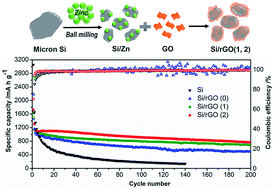Zinc-assisted mechanochemical coating of a reduced graphene oxide thin layer on silicon microparticles to achieve efficient lithium-ion battery anodes†
Abstract
In recent years, the development of high-performance and practical silicon–carbon composite anode materials has attracted significant interest for the advancement of new-generation lithium-ion batteries. Herein, using zinc powder as a sacrificial reducing agent, novel core/shell structured silicon/reduced graphene oxide (Si/rGO) hybrids were fabricated via a facile mechanochemical route. In particular, rGO nanosheets were effectively bound to the surfaces of ball-milled silicon particles via an in situ reduction reaction by zinc without any extra surfactants or binders. The well-established rGO coating layer on silicon is crucial and confers electronic conductivity and mechanical integrity to the acquired Si/rGO composites. Owing to the conductive rGO shells, which provided good charge transport properties and also confined the volumetric expansion of active silicon cores upon cycling, the optimal porous Si/rGO composite anode could achieve enhanced reversible capacities and superior cycling stability. After 200 charging–discharging cycles at the current density of 200 mA g−1, the Si/rGO composite still retained the high discharge specific capacity of 767 mA h g−1, and 548 mA h g−1 was retained at 500 mA g−1 after 300 cycles. Moreover, the Si/rGO composite delivered excellent high rate capabilities and cycling durability. Due to its low-cost, environmental-friendliness and scalability, this novel zinc-assisted coating strategy offers an alternative way to produce cost-efficient anodes for rechargeable batteries.



 Please wait while we load your content...
Please wait while we load your content...